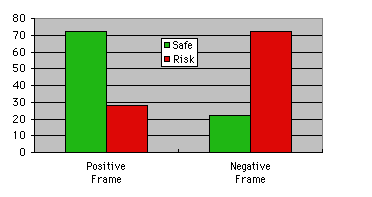
Framing II
Framing III
Framing IV
Framing V
Framing VI
Framing VII
Framing VIII
Loss Aversion, Risk, & Framing
The next stop in the framing inquiry involves the unique relationship
of risk taking to positive and negative framing. Since losses
loom larger than gains, it appears that humans follow conservative
strategies when presented with a positively-framed dilemma, and
risky strategies when presented with negatively-framed ones.
To illustrate, consider Kahneman & Tversky's 1981 study where
they asked a representative sample the following
Imagine that the U.S. is preparing for the outbreak of an
unusual Asian disease, which is expected to kill 600 people.
Two alternative programs to combat the disease have been proposed.
Assume that the exact scientific estimates of the consequences
of the programs are as follows: If program A is adopted, 200
people will be saved. If program B is adopted, there is a one-third
probability that 600 people will be saved and a two-thirds probability
that no people will be saved. Which of the two programs would
you favor?
Be sure to answer this question before you proceed.
Have you answered? OK.
Notice that the preceding dilemma is positively framed. It
views the dilemma in terms of "lives saved." When the
question was framed in this manner, 72% of people chose A,
the safe-and-sure strategy, but only 28% chose program B, the
risky strategy. An equivalent set of people considered the
Imagine that the U.S. is preparing for the outbreak of an
unusual Asian disease, which is expected to kill 600 people.
Two alternative programs to combat the disease have been proposed.
Assume that the exact scientific estimates of the consequences
of the programs are as follows: If program C is adopted, 400
people will die. If program D is adopted, there is a one-third
probability that nobody will die and a two-thirds probability
that 600 people will die. Which of the two programs would you
favor?
You can see that the two questions examine an identical dilemma.
Two hundred of 600 people saved is the same as 400 of 600 lost.
However, when the question was framed negatively, and people
were concentrating on losses rather than gains, they voted in
a dramatically different fashion. When framed negatively, 22%
of the people voted for the conservative strategy and 78%
of them opted for the risky strategy!

 As you can see, framing the choice positively
vs. negatively caused an almost perfect reversal in choices--saving (or is that 'not losing'?) lives! Clearly,
framing can powerfully influence the way a problem is perceived,
which in turn can lead to the favoring of radically different
solutions.
As you can see, framing the choice positively
vs. negatively caused an almost perfect reversal in choices--saving (or is that 'not losing'?) lives! Clearly,
framing can powerfully influence the way a problem is perceived,
which in turn can lead to the favoring of radically different
solutions.
Let's consider the same "negative frame => risky behavior"
phenomenon from a somewhat less theoretical and more practical
perspective. Imagine that you are a medical practitioner, and
you have just seen your third case of advanced breast cancer
in a single week. "Why," you wonder to yourself, "aren't
these women performing breast self-exams (BSEs) and finding these
lumps before they become full-fledged, life-endangering metastatic
cancers?" Your clinic hands a brochure on BSE to every woman
that enters the door, BSE is regularly described in newspapers
and on TV; information on this topic isn't exactly scarce! Why
do your patients choose to die rather than comply? you wonder.
But consider the act of a BSE. Logically, it's safe--but psychologically,
it's a risky procedure. If you perform BSE, you may feel a lump.
So performing BSE is a risky behavior, because by looking, you
may find something you don't want to find. Not performing a BSE
is a logical health risk behavior, but is safer psychologically.
By not looking, you won't find anything that may cause you to
worry.
Researchers Meyerowitz and Chaiken explored this very question
in a 1987 research project. They distributed one of two brochures
on BSE to equivalent patients in equivalent clinics. The brochures
were identical in terms of content, but one stressed the gains
associated with performing a BSE, and the other focused on the
losses associated with inaction. You can guess the result, can't
you? The negatively-framed brochure lead to higher positive BSE-related
attitudes and behaviors. Actually, the true strength of the negative
frame emerged four months after patients received the brochures.
Those who received negatively-framed brochures showed significantly
greater intentions to perform BSE at the later date.
Why is it that negative information causes increased persuasion
in these types of situations? Psychologists have long known of
the existence of the "positivity bias," which states
that humans overwhelmingly expect good things (as opposed to
neutral or bad things) to occur. If perceivers construct a world
in which primarily positive elements are expected, then negative
information becomes perceptually salient as a jolting disconfirmation
of those expectations (Kanouse & Hanson, 1972). We also know
that people stop to examine disconfirmations to a much higher
degree than confirmations. Negative information is often highly
informative and thus may be assigned extra weight in the decision-making
process (Fiske, 1980; Smith & Petty, 1996). Let me ask you:
if you learned that your friend's auto mechanic performed an
excellent valve job but botched his automatic transmission repair,
would you take your car to that mechanic? No, because negative
information overwhelms positive information. You expect a mechanic
to be effective, period.
This topic is considered in further detail for the benefit of my students, who must enter the URLs found on the syllabus to access the following pages (if you're not a student of mine, please don't ask! The answer will be "Sorry."):
- Positive & Negative Frames (They're both effective in the appropriate circumstances, but you need to know which is best to use when.)
- Why Experts Fail to Predict (One reason experts make stupid mistakes.)
- Framing by Position (The real reason for the cheap and expensive models in the product lineup.)
- Framing by Contrast (How contrast is used to make you do things you wouldn't otherwise do.)
- Framing by Attribution (One of the most seductive persuasion tactics around because it makes people feel good!)
I've left the following link active for everyone:
- Media Framing (How the media frames the news and shapes public opinion.)
www.workingpsychology.com
All rights reserved.
